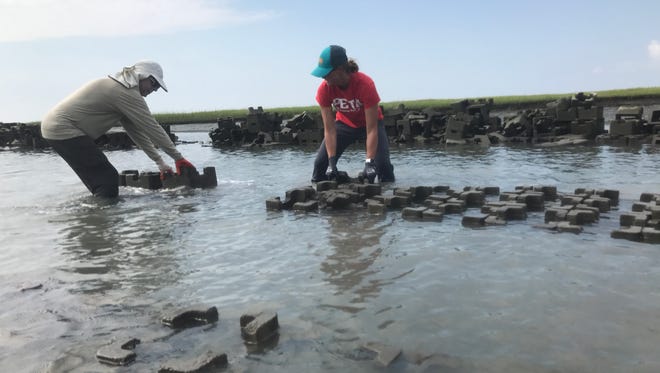Scientists hope concrete 'castles' will save shoreline, help oysters

At the southern tip of Hog Island Bay, volunteers dip and dunk into knee-deep water, hoisting 30-pound concrete blocks into neat rows along the shore.
It’s labor-intensive work, but building oyster castles is helping scientists understand how to better protect eroding shorelines, said Bo Lusk, coastal scientist with the Nature Conservancy's Virginia Coast Reserve.
“From this data, we’ll have a better idea of how to go forward with these reefs,” Lusk said, “and we’re going to get some great reef habitat out of it.”
Taking the punch out of waves
The Short Prong Marsh site is an ideal spot to study oyster castles, which are living reefs of oysters built on the concrete blocks, Lusk said.
“From one end of this project to another, it gets the same types of waves, so it’s a good place to test,” he said.
That’s important because one of the main goals of building these living shorelines is to see how effective they are at dulling waves that eat away at the land.
“We’re trying to maintain the marsh that is behind the reef, and that is important because the marsh can help dampen the waves and the storm surge when they come,” said Cristina Carollo, senior coastal scientist at the Conservancy's Virginia Coast Reserve.
“Ultimately, it’s really important because these marshes and the islands out here are protecting the people that live on the shore,” she said.

Scientists at The Nature Conservancy, in partnership with graduate students from University of Virginia, will use the Short Prong project to test four different oyster castle designs of varying widths and heights.
“We don’t know if it’s more effective to build a reef that’s higher, or a reef that’s wider,” Lusk said.
The question he hopes to answer: “How do we most efficiently use this?”
The oyster castles don’t just dampen waves, though.
RELATED: New oyster reefs protect Assateague Bay from storms
READ MORE: OC fishermen build reefs for new fisheries, blue water
They also provide surfaces for baby oysters, called spat, to land on and grow. As they become adults, the oysters create habitat for a whole host of marine life, from crabs and other shellfish to juvenile fish and the larger fish that eat them.
“That’s part of the reason we say an ‘oyster reef’— it’s all the other living things that are in there,” Lusk said.
The oysters also filter feed, which helps clear the water, remove excess nitrogen and allow light to reach and nourish the seagrass beds that other marine creatures call home.
Humble beginnings

A 2007 project by high school students in Charlottesville, Virginia, inspired the oyster castle projects underway on Virginia’s Eastern Shore.
Students wanted to do an oyster restoration project, but the “reef ball” design at the time was labor intensive, requiring someone to pack each mold by hand, Lusk said.
“We realized we’ve got to come up with something that we can pop thousands out of a mold,” he said, and the oyster castle concept was born.
Like oversized Legos, the 1-by-1-foot concrete blocks click into place to construct underwater fortresses ideal for oysters to land on and grow.
They’re small enough to move by hand, but when stacked together, the structures are sturdy enough to withstand waves, Lusk said.
“By using these oyster castles, you immediately get this height, this vertical relief,” he said. “We immediately have habitat and we immediately have some of this height that helps to block some of the waves as they approach the shore.”
Looking to the future

Scientists plan to monitor the Short Prong Marsh site to see which oyster castle structures best protect the shore.
They will also monitor the site to see how effective the oyster castles are at collecting live oysters over time, Lusk said.
In the meantime, volunteers from as far as Pennsylvania and northern Virginia will continue flocking to the marsh to help the Nature Conservancy staff assemble the castles, which they did last week and will continue the first week of September.
“You don’t often get the opportunity to create habitat for wildlife, and also to protect the property and the land base,” said Sue Rice, a volunteer from Machipongo and former refuge manager on the Eastern Shore.
“It’s just really unique and it makes me feel like I’m really doing something positive for the Eastern Shore.”
She joined the group of 14 toting blocks last week, a project that will continue next month.
“It’s twofold: We’re restoring oyster reef habitat, and we’re learning more about how to build oyster reefs to protect our shorelines,” Lusk said.